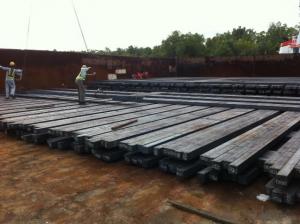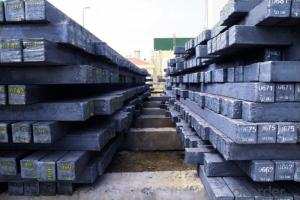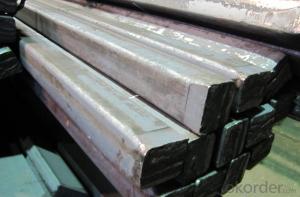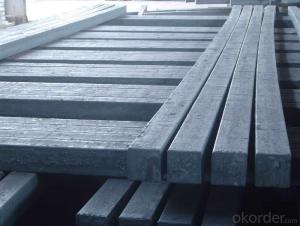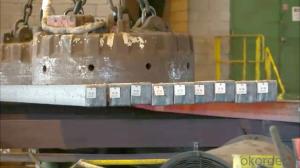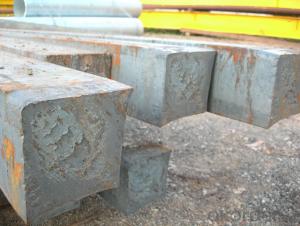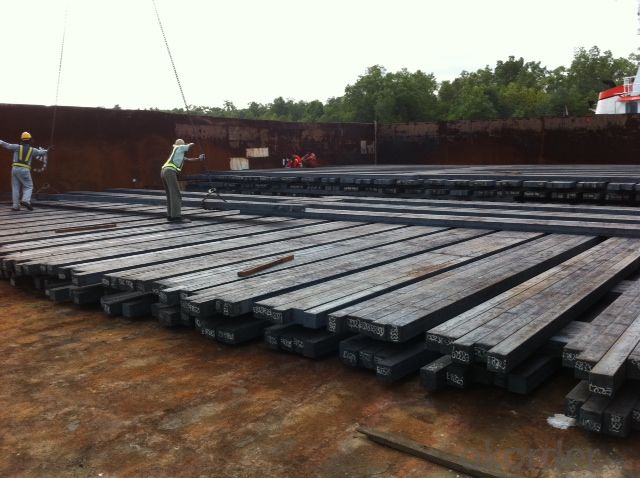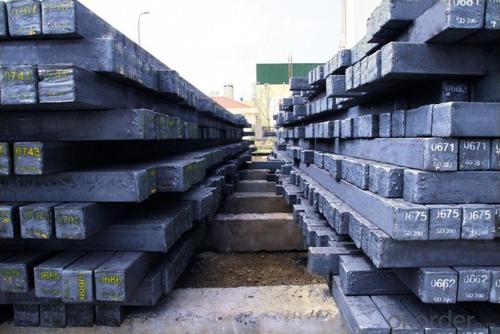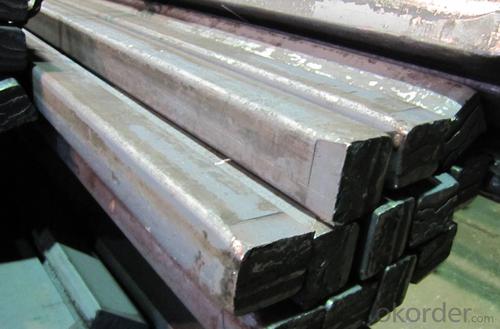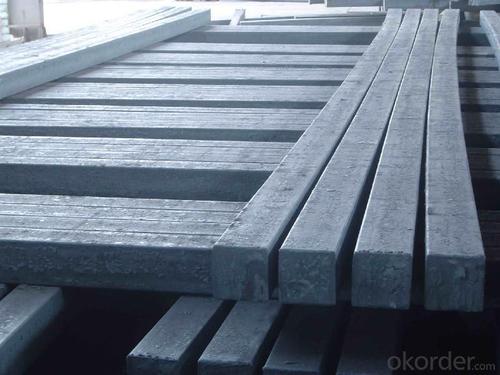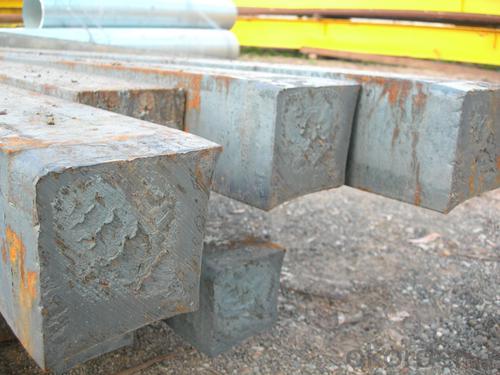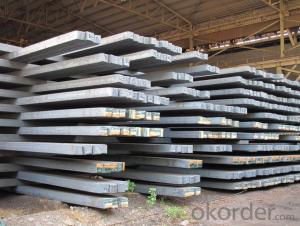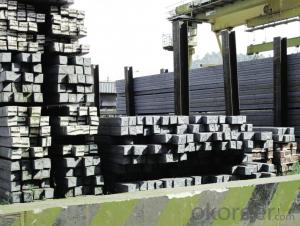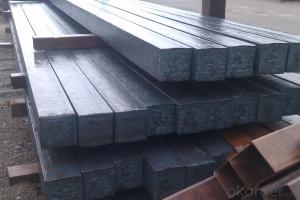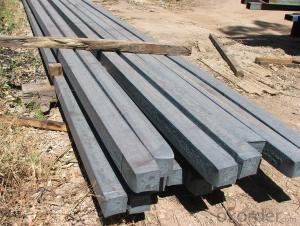Prime Q275 150mm Square Alloy Steel Billet
- Loading Port:
- Shanghai
- Payment Terms:
- TT OR LC
- Min Order Qty:
- 100 m.t.
- Supply Capability:
- 10000 m.t./month
OKorder Service Pledge
OKorder Financial Service
You Might Also Like
Structure of Prime Q275 150mm Square Alloy Steel Billet
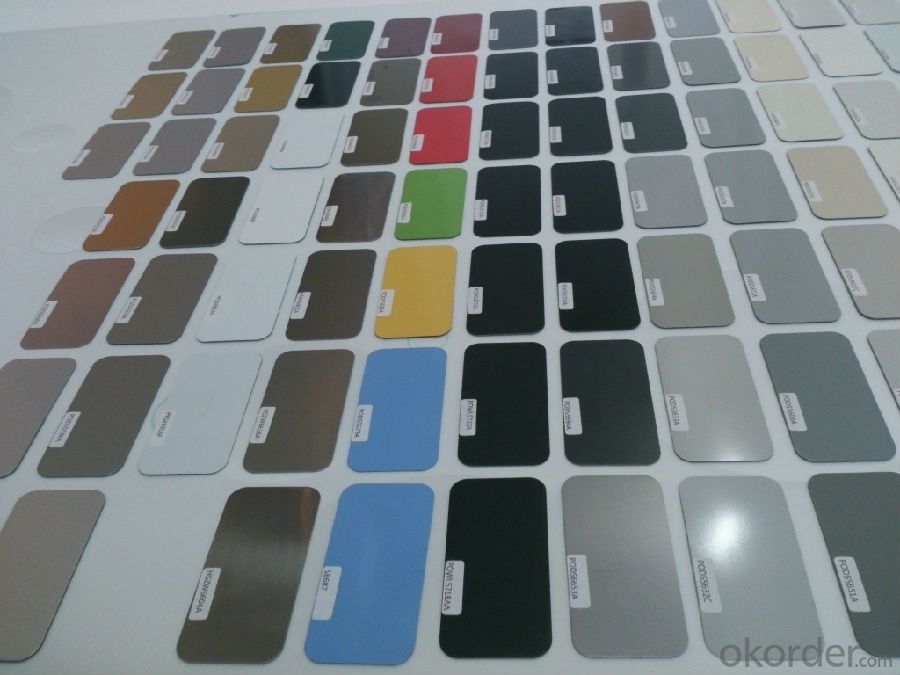
Description of Prime Q275 150mm Square Alloy Steel Billet
1. Prepainted steel coil is coated with organic layer, which provides higher anti-corrosion property and a longer lifespan than that of galvanized or galvalume steel sheets.
2. The base metals for prepainted steel coil consist of cold rolled, HDGI Steel, electro-galvanized and hot-dip alu-zinc coated steel. The finish coats of prepainted steel coil can be classified into groups as follows: polyester, silicon modified polyesters, polyvinylidene fluoride, high-durability polyester, etc.
3. The production process has evolved from one-coating-and-one-baking to double-coating-and-double-baking, and even three-coating-and-three-baking.
4. The color of the prepainted steel coil has a very wide selection, like orange, cream-colored, dark sky blue, sea blue, bright red, brick red, ivory white, porcelain blue, etc.
5. The prepainted steel coils can also be classified into groups by their surface textures, namely regular prepainted sheets, embossed sheets and printed sheets.

Main Feature of Prime Q275 150mm Square Alloy Steel Billet
They were one of several reasons for the wind to be taken out of the sails of the recent oil price momentum. Kuwait’s oil minister said that his country would only commit to a production freeze if all major producers are involved, including Iran. We also had Goldman telling us that oil markets will not rebalance at $40/bbl as it throws a lifeline to cash-strapped US producers.
If it is talk of a production freeze that is behind the rally it shows how low expectations have fallen. It is in the nature of oil people to talk the market up. Any bullish crumb is given exaggerated significance and any port in a storm will do. It is all but fact that the oil market will be tighter in the second half of this year when seasonal demand shoots up and US production continues to decline. It was the same picture last year. If OPEC and key non-OPEC production is frozen that will ensure the daily surplus will fall, but in all likelihood there will still be a surplus and there is an enormous global stockbuild to burn off.
Applications of Prime Q275 145mm Square Alloy Steel Billet
A. Corrugated design makes it excellent waterproof performance
B. Materials as prepainted steel sheets, galvanized steel sheets, galvalume (Al-Zn coated sheets) are available to make corrugated sheet.
C.Those material are durable, anti-corrosion in bad weather for 20-30 years based on it's Zinc(Galvanized) coating or AZ (Galvalume) coating.
D. Different shape of the sheet make it suitable for any style of buildings.
E.Easy to install, no need special tools to fix the sheet.
F.Light weight due to high strength to weight ratio of steel. Light weight means easier handling lower shipping costs, easier installation
G. Different color is availbe base on the RAL Standard make your building more beautiful.
H. We will provide the best solutions if you don't have a exact idea of the specification you want for the steel sheet based on your weather conditions, engineering structure, construction budget and so on.

Specifications of Prime Q275 150mm Square Alloy Steel Billet
Product | Billet |
Material Grade | SGCC / SGCH / DX51D+AZ, etc |
Thickness | 0.6-3.0mm |
Width | 500-1500mm |
Tolerance | Thickness: +/-0.02mm , Width:+/-2mm |
Zinc-coating | Z30-150g/m2 |
Technique | Raw material: Hot rolled steel coil --> Cold rolled_>hot dipped galvalume |
Surface | Dried, Chromated, Unoiled |
Spangle | Regular spangle , small spangle, zero spangle |
ID | 508MM 610MM |
Coil weight | 1-25MT |
Export package | Cardboard inner sleeves, Waterproof paper, galvanized steel covered and steel strip packed |
FAQ of Prime Q275 150mm Square Alloy Steel Billet
We have organized several common questions for our clients,may help you sincerely:
1. How Can I Visit There?
Our company is located in Tianjin City, China, near Beijing. You can fly to Tianjin Airport Directly. All our clients, from home or aboard, are warmly welcome to visit us!
2. How Can I Get Some Sample?
We are honored to offer you sample.
- Q: Can steel billets be used in the production of marine equipment?
- Yes, steel billets can be used in the production of marine equipment. Steel is known for its strength, durability, and corrosion resistance, making it a suitable material for marine applications. Steel billets, which are semi-finished products in the steel manufacturing process, can be further processed and transformed into various marine equipment components such as ship hulls, propeller shafts, rudders, and offshore structures. The high strength-to-weight ratio of steel makes it ideal for handling the demanding conditions encountered in marine environments, including exposure to saltwater, extreme temperatures, and mechanical stresses. Additionally, steel can be easily fabricated, welded, and machined, allowing for the customization and production of complex marine equipment designs. Overall, steel billets are a valuable raw material in the production of marine equipment due to their strength, durability, and suitability for marine applications.
- Q: which companies are, and how the billet sales, how can we sell billet to ask for advice, thank you
- The main mold manufacturers, equipment manufacturers, military departments, measuring and cutting tools manufacturers.As for sales, one to information, two to high quality and low price, three to find relations.
- Q: What are the specifications for tool steel billets used in the tooling industry?
- Tool steel billets used in the tooling industry typically have specific specifications to ensure optimal performance and durability. These specifications include: 1. Composition: Tool steel billets are made from specific alloy compositions that provide high hardness, wear resistance, and toughness. Common elements found in tool steel include carbon, chromium, vanadium, molybdenum, and tungsten. 2. Hardness: Tool steel billets are heat-treated to achieve a desired hardness level, typically measured in Rockwell hardness (HRC). The hardness required depends on the specific application and the type of tool being produced. 3. Size and shape: Tool steel billets come in various sizes and shapes, such as rectangular or round bars, to cater to different tooling requirements. The dimensions of the billets are chosen based on the size and complexity of the tool being manufactured. 4. Surface finish: Tool steel billets should have a smooth and clean surface finish to ensure easy machining and minimize the risk of defects or imperfections in the final tooling product. 5. Tolerance: The billets should be manufactured with tight dimensional tolerances to ensure consistency during the machining and tooling processes. This helps in achieving precise tool dimensions and minimizing wastage. 6. Homogeneity: Tool steel billets should have uniform chemical composition and microstructure throughout to ensure consistent mechanical properties and performance of the final tooling products. 7. Heat treatment properties: The billets should have good heat treatment properties, including the ability to be hardened and tempered, to enhance their strength, toughness, and wear resistance. 8. Machinability: Tool steel billets should have good machinability to allow for efficient shaping and forming processes during tool manufacturing. This includes considerations for cutting forces, chip formation, and surface finish. It is important to note that the specific specifications for tool steel billets can vary depending on the application and the type of tool being produced. Manufacturers and tooling experts often work closely together to determine the most suitable tool steel specifications for each specific tooling requirement.
- Q: What are the different types of surface defect detection methods for steel billets?
- Steel billets are subject to various methods of surface defect detection. Among the techniques commonly used are visual inspection, magnetic particle inspection, ultrasonic testing, eddy current testing, and laser scanning. 1. The simplest and most traditional method is visual inspection, where trained inspectors visually examine the surface of steel billets for cracks, scratches, or foreign material. 2. Magnetic Particle Inspection (MPI) is a non-destructive testing method that uses magnetic fields and iron particles to detect surface defects. The billet is magnetized, and iron particles are applied to the surface. Any defect causes a leakage of magnetic flux, attracting the iron particles and forming visible indications. 3. Ultrasonic Testing (UT) utilizes high-frequency sound waves to detect internal and surface defects in steel billets. Ultrasonic waves are emitted into the billet by a transducer, and the reflected waves are analyzed to identify flaws or irregularities. 4. Eddy Current Testing (ECT) makes use of electromagnetic induction to detect surface defects. A coil carrying an alternating current is placed near the billet's surface, generating eddy currents. Any variation in the surface, such as cracks or corrosion, alters the eddy currents, which are then detected by the instrument. 5. Laser Scanning is a relatively advanced method that employs laser technology to scan the surface of steel billets. The laser beam reflects off the surface, and a sensor analyzes the reflected light to identify surface defects like scratches or dents. These methods differ in terms of sensitivity, speed, and cost-effectiveness. The selection of the appropriate surface defect detection method depends on factors such as the required level of accuracy, the types of defects to be detected, and the specific requirements of the industry.
- Q: How are steel billets transported internationally?
- Steel billets are transported internationally through various modes of transportation depending on the distance, quantity, and urgency of the shipment. The most common methods include shipping, rail, and road transportation. For long-distance international transport, shipping is the preferred mode. Steel billets are loaded into shipping containers, typically either 20-foot or 40-foot containers, and secured to prevent movement during transit. These containers are then transported by cargo ships, which offer large storage capacities and efficient transportation over vast distances. Shipping containers are designed to protect the steel billets from external elements such as moisture and corrosion, ensuring their integrity upon arrival. Rail transport is also utilized for international shipments, especially for destinations connected by rail networks. Steel billets are loaded onto railcars, either in open-top or covered wagons depending on the requirements and weather conditions. Rail transportation is often preferred for its cost-effectiveness, capacity to handle large volumes, and ability to reach landlocked regions. In cases where the distance is relatively short or when the shipment requires quick delivery, road transportation is employed. Steel billets are loaded onto flatbed trucks or trailers, securely tied down to prevent any movement, and transported to their destination. Road transport offers flexibility, as it allows direct delivery to the intended location, including areas where other modes of transport may face limitations. Regardless of the mode of transportation, international shipments of steel billets require proper documentation, including customs clearance, bill of lading, and other relevant paperwork. These ensure compliance with international trade regulations, smooth border crossings, and timely delivery of the steel billets to their destination.
- Q: What is the role of steel billets in the manufacturing of construction machinery?
- Steel billets play a crucial role in the manufacturing of construction machinery as they serve as the raw material for producing various components and structures. These billets are initially heated and then shaped or machined into different forms such as plates, beams, or rods, which are essential in constructing the frames, chassis, and other structural parts of construction machinery. The high strength and durability of steel make it ideal for withstanding heavy loads and harsh working conditions, ensuring the reliability and longevity of construction machinery.
- Q: What are the different types of steel billets available?
- There are several different types of steel billets available, each with its own unique properties and uses. Some of the most common types include: 1. Carbon Steel Billets: These are made primarily of iron and carbon, with trace amounts of other elements. They are known for their high strength and durability, making them suitable for a wide range of applications such as construction, automotive, and machinery manufacturing. 2. Alloy Steel Billets: As the name suggests, these billets are made by adding various alloying elements such as chromium, nickel, or manganese to the carbon steel. This enhances the mechanical properties of the steel, making it more resistant to corrosion, wear, and heat. Alloy steel billets are commonly used in the production of tools, gears, and high-strength components. 3. Stainless Steel Billets: These billets contain a minimum of 10.5% chromium, which gives them excellent corrosion resistance. Stainless steel billets are widely used in industries such as food processing, chemical, and medical, where hygiene and resistance to rust are crucial. 4. Tool Steel Billets: Designed for applications requiring high hardness, wear resistance, and toughness, tool steel billets are often used in the production of cutting tools, dies, and molds. They are made by adding elements such as tungsten, vanadium, or molybdenum to carbon steel, resulting in a material capable of withstanding extreme conditions. 5. Low Alloy Steel Billets: These billets contain small amounts of alloying elements, typically less than 5%, such as manganese, silicon, or copper. They offer improved strength, toughness, and weldability compared to carbon steel, making them suitable for structural applications in construction and engineering. 6. Microalloyed Steel Billets: Also known as HSLA (High-Strength Low-Alloy) steel, microalloyed steel billets contain small amounts of niobium, vanadium, or titanium. This results in a fine-grained microstructure and enhanced strength, allowing the production of lighter and more efficient structures in industries such as automotive and aerospace. These are just a few examples of the different types of steel billets available. Each type has its own specific properties and applications, and choosing the right type depends on the intended use and desired characteristics of the final product.
- Q: Can steel billets be used in the production of sculptures and artwork?
- Sculptures and artwork can indeed utilize steel billets. Steel, being a versatile and malleable material, empowers artists to fashion one-of-a-kind and intricate designs. The inclusion of steel billets in sculptures and artwork guarantees sturdiness, resilience, and the potential for expansive installations. Artists can skillfully mold, fuse, and manipulate steel billets to generate an extensive array of sculptures, ranging from abstract shapes to figurative representations. The utilization of steel also contributes a contemporary and audacious touch to the artwork, thanks to its industrial aesthetic. Moreover, artists can opt to employ diverse techniques such as painting, patina, or polishing to further enrich their creative vision. In summary, steel billets present an exhilarating prospect for artists to delve into and stretch the boundaries of their artistic expression.
- Q: What is the role of steel billets in the construction of residential buildings?
- Residential building construction heavily relies on steel billets, which have a crucial function. These elongated steel bars, with their rectangular shape, act as the primary raw material for producing different structural components used in the construction process. One major application of steel billets lies in the creation of reinforced concrete structures. Due to its exceptional strength and durability, reinforced concrete finds extensive use in building foundations, columns, beams, and slabs. To enhance the structural integrity of the building and provide tensile strength, steel billets are employed in the manufacturing of rebar. This rebar is then embedded within the concrete, allowing the building to withstand external forces like wind, seismic activity, and its own weight. Moreover, steel billets find utility in the production of steel beams and columns. These components play a crucial role in supporting the building's weight and transferring loads from the upper floors to the foundation. Steel beams offer superior strength and rigidity, enabling the construction of open and spacious interiors without the need for excessive support walls. This not only provides design flexibility but also maximizes the usable space within residential buildings. Steel billets also contribute to the construction of stairs, handrails, and balconies. These architectural elements necessitate materials with high strength to ensure the structure's safety and longevity. By providing the necessary strength and stability, steel billets enable safe and secure access to different areas of the building. In conclusion, steel billets are of utmost importance in residential building construction, serving as the raw material for various structural components. From reinforced concrete structures to steel beams, columns, and other architectural elements, steel billets play a vital role in ensuring the strength, durability, and overall safety of residential buildings.
- Q: How are steel billets used in the shipbuilding industry?
- Steel billets are used in the shipbuilding industry as a primary raw material for manufacturing various components of a ship's structure, such as hulls, decks, and bulkheads. These billets are melted, cast, and then rolled into the desired shape or size to meet the specific requirements of the ship's design. The high strength and durability of steel make it ideal for withstanding the harsh marine environment and ensuring the structural integrity of the vessel.
Send your message to us
Prime Q275 150mm Square Alloy Steel Billet
- Loading Port:
- Shanghai
- Payment Terms:
- TT OR LC
- Min Order Qty:
- 100 m.t.
- Supply Capability:
- 10000 m.t./month
OKorder Service Pledge
OKorder Financial Service
Similar products
Hot products
Hot Searches
Related keywords
